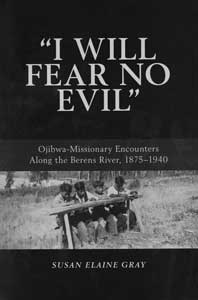by Richard Preston
Department of Anthropology, McMaster University
This article was published originally in Manitoba History by the Manitoba Historical Society on the above date. We make this online version available as a free, public service. As an historical document, the article may contain language and views that are no longer in common use and may be culturally sensitive in nature.
Please direct all inquiries to webmaster@mhs.mb.ca.
Help us keep
history alive!Susan Elaine Gray, “I Will Fear No Evil:” Ojibwa-Missionary Encounters Along the Berens River, 1875-1940 Calgary: University of Calgary Press, 2006, 214 pages. ISBN 1552381986, $29.95 (paperback).
 Dr. Gray makes the central point that we have been too easily (sometimes inadvertently) caught up in negative assessments of “the missionary imposing Christianity on the disempowered Native.” She goes on to show how this is not only wrong; it is also in varying degrees stereotyping, judgmental, and condescending. People everywhere make choices as to what they will believe, and it is rare that the situation is so coercively limited that they must make choice-less choices.
Dr. Gray makes the central point that we have been too easily (sometimes inadvertently) caught up in negative assessments of “the missionary imposing Christianity on the disempowered Native.” She goes on to show how this is not only wrong; it is also in varying degrees stereotyping, judgmental, and condescending. People everywhere make choices as to what they will believe, and it is rare that the situation is so coercively limited that they must make choice-less choices.
Gray makes this central point with some judicious subtlety of method, by summing up her study with a thoughtful inventory of points held in common between the two traditions (p. 155-156), where a more celebratory mission history or a politically engaged criticism would be content to describe points of difference. In their writings about the Natives and their rival missionaries, points of difference were very much in evidence. In contrast, most Native people were able to distinguish between the personal narrow-mindedness of the missionaries (seen as partially flawed individuals) and the unencumbered inclusiveness of the one God that they all looked to.
We are shown that there is a sustained pattern of exclusivity in the thinking and preaching of both Methodist and Catholic missionaries, in contrast to the inclusivity of Ojibwa folks as they seek to understand the messages of the Christian Bible. When the individual missionaries stayed for enough years and were open enough to learn something of the Ojibwa views, they became more secure in their situations and able to be more flexible, and everyone benefited. As the Ojibwa individuals sustained their careful scrutiny of the meanings in the Bible, understanding came. On the whole, people’s traditional “bush” beliefs were not so much disconfirmed or rejected as they were blended by the incorporation of Christian specifics into a syncretic spirituality that allowed people to make their own personal choices (146ff).
Sometimes the choice is to put aside drumming and conjuring, and sometimes not. The number and intensity of relations with non-Natives was strongest around the settlement of Berens River, on the coast of Lake Winnipeg, simply because it was easy to access. Accordingly, pressures to take on white practices and attitudes were stronger at Berens River than at the inland settlements of Little Grand Rapids or Pikangikum. William Berens, Chief (and son of a chief) at Berens River, chose to take on a more modern form, but felt that he could have chosen either path, and could have changed his mind if he had wished to. Implied here is the necessary basis for such a change, in deep knowledge of Ojibwa spirituality as well as Christian spirituality.
Once again we are treated to a rethinking of A. Irving Hallowell’s classic works on Ojibwa spirituality and worldview, as Mary Bartholomew Black did in her PhD dissertation in the 1960s. Black’s rationalist, ethno-scientific methodology was a marked contrast with Hallowell’s gestalt-inspired ethnography. Hallowell commented to me that it was nice to be confirmed in that systematic fashion, but that he was glad he had not had to write in that genre himself. Gray would agree. In place of methodological rigour, we are given a rich corpus of first hand verbatim statements by a good number of Berens River folks, complemented by Gray’s work in written archives and her rich comparative information on spiritual incorporation and syncretism. Her intellectual breadth is very pleasing, ranging from Johannes Brahms on the spiritual nature of his creative work to Northrop Frye on the centrality of (religious) myth in his life, and in all of our lives.
In my own work on East Cree spirituality I found close parallels to much of what she describes in this book. The deep resonance for Ojibwa of statements regarding Jesus’ sacrificial blood is strikingly comparable to what I have learned from Crees of James Bay, and speaks to the sacrificial blood of animals who at a somewhat mysterious spiritual level give their bodies so that humans can eat, and live. They give the hunter and his family life in this world, and hunters were careful to save and eat the blood, and not to leave it where it could be seen to be wasted. At another somewhat mysterious level, it was said that Jesus’ blood promises forgiveness for wrongdoings and a safe passage to eternal life. The ritual eating of Jesus blood and flesh has a direct resonance. And we can appreciate the widespread Ojibwa and Cree admiration of the painting “The Last Supper.”
Page revised: 15 September 2013